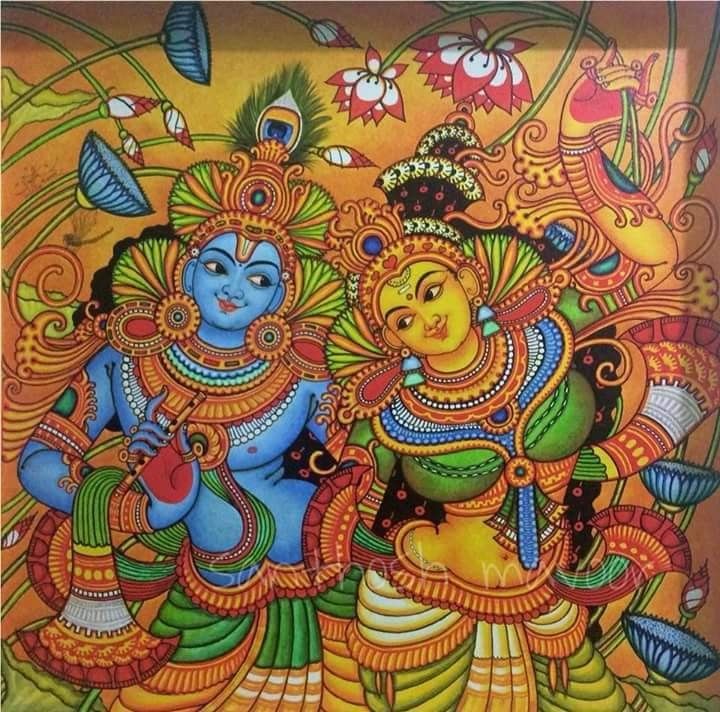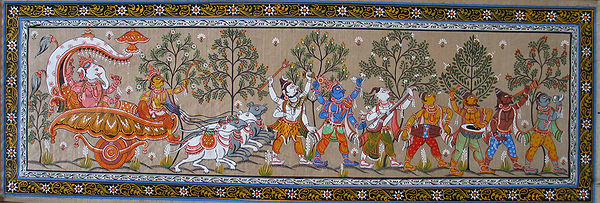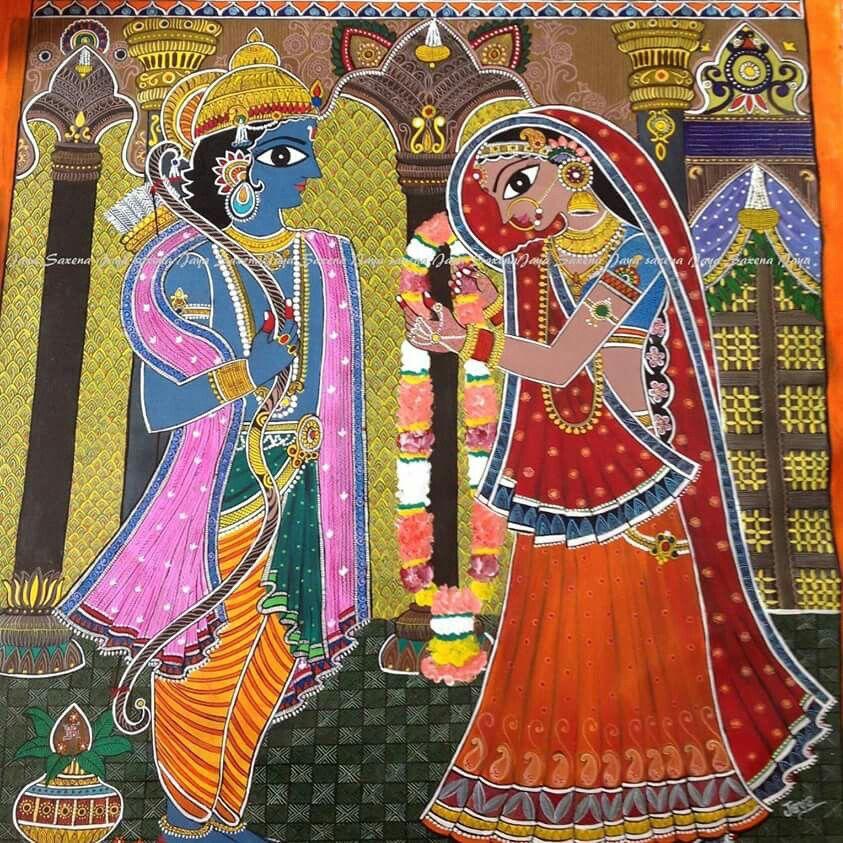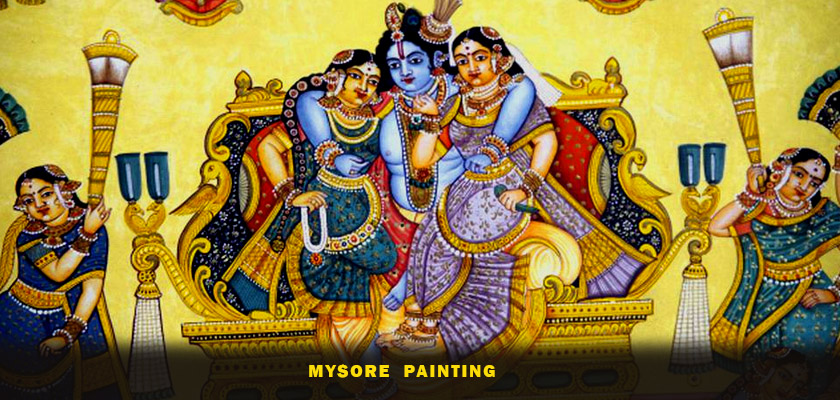India has always been special because of its Unity in Diversity. It can be the language, cultural diversity or folk art. India does not necessarily need colours and canvas for art, one can find Indian art on clay, stone, marble, wood, fabric, cloth, wall, leaves, etc. India has popular Indian Traditional Paintings passed down generations to generations and still has the importance in 2020.
“Beauty of the History, from past to forever.”
As every state of India has some arts and handicrafts to offer, here is a list of popular Indian Traditional Paintings. A variety of art forms have evolved over the years but still, some are untouched by modernization, and still using traditional techniques, keeping the originality of art. Indian folk art is still alive in many parts of the country.
Indian Traditional Paintings
Warli Painting



Originated in 2500 BCE, Warli art is the traditional folk art of Maharashtra. It is one of the styles of tribal art. The tribal people from the north Sahyadri range in India created it.
These wall paintings generally use a set of basic geometric shapes such as a triangle, a circle and a square. These shapes have a symbolic meaning of different elements of nature. Initially, the Warli artists used their clay huts as a canvas to vent their artistic urges. Using the shapes they make human-like figures with concepts like daily activities, such as dancing, farming, fishing, celebrations, motherhood, etc.
The Warli paint is done only with a white pigment (obtained from a mixture of rice paste, water and gum) on a red or dark red background.
Kerala Mural Painting



Mural Paintings of Kerala are a picture of Hindu Mythology and legends, which are drawn on the walls of temples. History of this art is back between 9th to 12th centuries CE. The temples and palaces of Kerala are all a visual treat with the stories of ancient Hindu Gods and Goddesses.
A mural is an artwork painted or applied directly onto walls, ceilings or any other permanent surface. But today the art has shifted from wall murals to paintings on canvas and paper. Colors are prepared from vegetable and mineral pigments. The most frequently used pigments in Kerala murals are saffron-red, saffron-yellow, green, red, white, blue, black, yellow and golden-yellow.
The oldest of the murals found in Kerala are those in the Thirunandikkara Cave temple which is now a part of Kanyakumari district of Tamil Nadu. These paintings are a symbol of natural beauty and grace, elegance and simplicity.
Kalamkari Painting



Kalamkari is one of the most famous crafts of Andhra Pradesh and known all over the country for its beauty. Spanning a history of 3000 years, it is a type of hand-painted or block-printed cotton textile produced in Andhra Pradesh.
Kalamkari comes from to words:- Kalam- pen and Kari- work, i.e, the artwork was done using a pen. This ancient art is basically done on cotton or silk fabric with tamarind using natural dyes. This art uses motifs like mythological figures, peacocks, flowers, elephants, horses and fish.
The art primarily uses colours like indigo, mustard, rust, black and green extracted from natural sources. The Black colour is extracted by blending jaggery, water and iron fillings. Yellow is derived from pomegranate peels and blue is obtained from indigo. Mixing yellow and blue together gives the colour blue and red colour is obtained from the bark of madder. Flowers are also used in abundance to extract colours.
As it is such beautiful art and a lot of hard work goes into the process as dyeing, bleaching, hand painting, block-printing, starching, cleaning and more.
Pattachitra Painting



Pattachitra or Tasar painting is a form of painting on cloth. Originated in Raghurajpur-Odisha, this art is a traditional hand-art form and uses natural colours. It visualizes mythological stories and intricate views of temples and folktales.
Chitrakaras or the Painters, paint this art from their home with family members. They pass the art from generations to generations.
Patta paintings are done on small strips of cotton cloth. The canvas is prepared by coating the cloth with a mixture of chalk and gum made from tamarind seeds. Then it is rubbed by taking the help of two different stones and then the cloth is dried. The mixture of gum and chalk gives the cloth’s surface a leathery finish on which the artists paint with vegetable, earth and stone colours.
Then the expert artists simply draw directly with the brush either in light red or yellow. Then the colours are filled in. To prevent from weather a lacquer coating is applied and that also makes the piece glossy. The brushes used by the ‘Chitrakaras’ are made of the hair of domestic animals. It’s not only artistic but also eco-friendly !!
Artists put the stories from the epics Ramayana, Mahabharata, Ganesha, Radha-Krishna, Goddess Durga and many mythological pasts.
It is best for any living space, to give the traditional touch and beautify the space.
Madhubani Painting



Madhubani painting, also called Mithila painting, is a traditional folk art of Bihar. This 2500-year-old art has traditionally been done by the women of the villages on freshly plastered mud walls of huts but now it is being done on cloth, handmade paper and canvas.
During the time of Ramayana, king Janaka asked an artist to capture his daughter Sita’s wedding to Prince Rama. That’s when the art originated in Mithila. These paintings were usually created by women on walls and floors of homes during festivals, ceremonies or special occasions.
These paintings depict nature, Hindu religious motifs, and natural objects like the sun the moon and the themes naturally revolve around Hindu deities. Painting tools include a variety of tools including twigs, brushes nib pens, matchsticks and even fingers. There are rarely any blank spaces in these paintings. They are completely made with natural materials and dyes.
In the current generation, these paintings are also used to create social awareness on education, eve-teasing, social norms and women empowerment. Madhubani painting exhibitions on tree trunks helped fight deforestation in 2012. More than 100 trees were saved as paintings were drawn on them.
Now, that’s the magic of art !!
Madhubani also has art lovers from different countries like USA, Australia, UK and Russia. Today these patterns of this art form can be seen into various items like bags, cushion covers, bookmarks, coasters, crockery and even sarees.
Know more such interesting facts about Indian handicrafts.
Tanjore Painting



Tanjore painting is a classical South Indian painting style which originated in the Thanjavur or Tanjore town of Tamil Nadu. This art form is dated back about 1600 AD.
Tanjore paintings have been influenced by Deccani, Vijayanagar and Maratha styles of painting. The motifs include Hindu gods, goddesses and saints and episodes from Hindu religious texts. The paintings are panel paintings done on wooden planks with glittering gold foils.
These paintings are characterised by rich and vivid colours, simple iconic composition, glittering gold foils overlaid on delicate but extensive gesso work and inlay of glass beads and pieces or very rarely precious and semi-precious gems.
In modern times, these paintings have become souvenirs for festive occasions in South India – colourful pieces of art to decorate walls.
Gond Art Painting



Originated 1400 years ago, by the Gondi tribe Gond Art is a painting form from the state of Madhya Pradesh.
According to the Gond belief system, each and everything whether it is a hill, river, rock or a tree is inhabited by a spirit and, consequently, is sacred. And to the connection to mankind and mark of respect, these paintings mainly depict flora, fauna and nature.
Artists use very bright vivid colours such as white, red, blue and yellow. The paints are usually derived naturally from objects such as charcoal, coloured soil, plant, leaves and even cow dung. The painting is a combination of lines. Artists uses lines in such a way that it conveys a sense of movement to the still images. Dots and dashes are added to impart a greater sense of movement and increase the amount of detail.
Initially painted on walls and floors and instead now painted on canvas and art lovers can easily take along. And also modern Gond art and artists have started to use poster colours.
This Art form has made its placed not only in India but also in other countries and can be sold very expensively.
Every state in India has a rich collection of art to offer to the art world. Do check out the Famous Indian handicrafts from every state of India.
Thangka Painting



Thangka painting is a Tibetan Buddhist painting which is very popular in Arunachal Pradesh. The painting is done on cotton, silk applique, usually depicting a Buddhist deity, a Buddhist scene or a Mandala.
Thangkas painting consists of a picture panel which is painted or embroidered over which a textile is mounted and then over which a cover, usually made of silk is laid. They can last a long time due to its process of making, but as they are very delicate they need to be stored in dry places to avoid moisture effect on them. They are also called as scroll painting.
The subject matter includes Buddha, bodhisattvas, goddesses, humans, stupas, animals, plants, flowers etc. The paintings are an important mode of religious expression, on the monastery walls and in religious festivals. Thangka serves as important teaching tools depicting the life of the Buddha, monks, lamas and the bodhisattvas. In the modern era, they are also used in homes for a traditional look and religious beliefs.
Rajput Painting or Rajasthani Painting



Originated during the 17th and 18th centuries, the Rajput paintings were the pride of the royal courts of Rajputana in Northern India. Every Rajput kingdom has a unique style in these paintings.
The paintings were not limited onto canvas, artists also made them on the walls and ceilings of many palaces and forts. This ancient art can still be seen on the walls of City Palace in Udaipur.
Rajasthani paintings had another form called Miniature paintings which were done on manuscripts, silk, paper, wood and sometimes on marble and ivory. Colours used in this art are all made of natural material and brushes were made up of hair from squirrel’s tail. The attractive paintings were done with fine detailing and fine brush strokes with bright colours.
These paintings generally portrayed the social life of the people at the time of medieval period, lives of common people as well as the royals, Hindu mythologies, creatures, desserts and a glimpse of the land of Rajasthan.
Mysore Painting



Originated since the 2nd century B.C. to 7th century A.D, Mysore paintings are south Indian paintings of Karnataka. These evolved during the reign of the Vijayanagar Kings.
Mysore paintings are widely acclaimed for their opulence and attention to detail. In ancient times artists used vegetable and mineral colours. Today the painting is done with commercially available media like poster and watercolours. Just like the above mentioned Tanjore paintings, these paintings use thinner gold leaves and require much more hard work.
They are not just paintings or decoratives. They generate felling, emotion and humility of the viewer. They mainly depict pictures of Hindu Gods and Goddesses and scenes from Hindu mythology.
Phad Painting



Originated more than 700 years ago in the Bhilwara region of Rajasthan. Phad painting is a religious scroll painting. This legacy passed down over generations within a single-family. Unbelievable!!!
Phad paintings narrate elaborate religious stories of gods and local deities as Devnarayanji (a reincarnation of Vishnu) and Pabuji (a local hero). Usually, a priest and his wife, called bhopa and bhopi, belonging to the Rabari tribe use these paintings as a part of an elaborate song-and-dance performance.
They travel from village to village to perform and use the phad paintings as visual aides and mobile temples. They perform dramatic actions of stories from the Ramayana, Hanuman Chalisa and other mythological tales. Phad means ‘fold’ in the local dialect as the paintings are unfolded after sunset and the performance is done all night for the villagers.
To make a Phad painting, hand-woven cotton cloth is soaked overnight to thicken the threads. Then stiffened with starch from rice or wheat flour, stretched, dried in the sun and rubbed with a moonstone to smoothen the surface.
Traditionally, the phads are painted with vegetable colours, flowers and stones. orange is used for limbs, yellow for ornaments and clothing, green for nature, brown for architectural designs, red to symbolize royal clothing and blur for curtains. The eyes are added in the last and the important part.
The traditional artists of this folk art-form are from the Joshi Family of Bhilwara. Chitrashala, or previosly called Joshi Kala Kunj was established by Shree Lal Joshi Ji to pass on the legacy by teaching the art within and outside the family. When a single family can make the art form alive since centuries, then we all can surely save these arts by doing our bit.
Pichwai Painting



Pichwai originated over 400 years ago in Rajasthan. The word generally came from Pich meaning back and ‘Wai’ means ‘textile hanging’. These paintings were originally used to decorate the Shrinathji ki Haveli in Nathwada, near Udaipur.
These paintings are made on cloth. They generally depict tales from Lord Krishna’s life. Common subjects found on these paintings are Gopis, Radha Krishna, Cows, Rasleela, Govardhan Puja, Diwali, Holi, Lord Vishnu, etc. The artist takes several months to complete the masterpiece. The paintings reveal the complete stories from the life of Krishna.
The colours and brushes used are all made up of natural materials. Intense and bright colours are used such as red, yellow, green, black along with the border of gota, swarovski or dabka work. They are also beautified with using gold.
The motive behind the making of these paintings is the joy and happiness in Vrindavan during Krishna times. With the modernisation, these paintings are not confined to the temple walls. They are now used as home decors and available in smaller sizes too.
Jadupatua painting



Jadupatua painting is an art practiced by the Santhal tribe of West Bengal, Bihar and Jharkhand since late 18th century. The painters are called as Jadupatuas or Duari Patuas. Jadu Patuas means Magic Painters. The wall paintings of Ajanta and Ellore are the testimonials of this art.
Jadupatua paintings are scroll paintings that are executed on cloth and on paper. They paint to preserve the crops, avert diseases, honour the dead, adventures of Krishna, festivals of Santhals and so on. The main themes are the story of creation according to the Santhal tradition and their dance and music and sometimes death images and life after death.
When someone dies in the village, then the Jadupatua artist visits them and analyses the death. And then on that basis the painting is done without pupil’s in the eyes of the image. And only after the family pays offerings or ‘daan’ the artist performs the Chakshudaan or “bestowal of sight” by painting the iris in the blank eyes of the portrait in order to free the dead person’s soul and send it to heaven.
They are painted on both cloth and paper using natural colours like soot, vermilion and mud from the riverbank while the hair of the goat or the quill of a porcupine serves as a raw material to make brush. The two ends of the cloth are sewn around bamboo sticks so that the scroll could be rolled and carried around. Some scrolls were short and consisted of only two or three panels while others could contain fourteen or more.
The colours used to make these paintings were produced using vegetables and minerals and the paint-brushes used were made of goat’s hair. Despite of using limited colours , this art depicts expresions, human figures and themes.\
Cheriyal Scroll Painting



Cheriyal Scroll Painting is a stylized version of Nakashi art, rich in the local motifs peculiar to the Telangana. They are at present made only in Hyderabad, Telangana, India.
The scrolls are painted in a narrative format, much like a film roll or a comic strip, depicting stories from Indian mythology, and intimately tied to the shorter stories from the Puranas and Epics. Earlier, these paintings were prevalent across Andhra, as also various other parts of the country, albeit flavoured with their distinct styles and other local peculiarities dictated by the local customs and traditions.
In the same way, Cheriyal scrolls must have been popular across Telangana in earlier times, though with the advent of television, cinemas and computers it has been fenced into its last outpost, the Cheriyal town.
Image Source:Wikipedia
Conclusion
Though these paintings are quite similar to each other but each has a different history and a unique style. And they have made their beautiful journey from temples to homes which also show the love of people towards history, Indian art and culture.
These were the Popular Indian Traditional Paintings that are passed down generations and are still loved by Indians and abroad. These days they can be seen in their birthplaces, in the Art galleries of the country and Online. Let’s take a moment to praise the art and support the artisans.
Please share as sharing is caring!!


7 thoughts on “14 Popular Indian Traditional Paintings passed down generations”